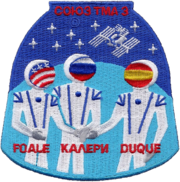Soyuz TMA-3
| Operator | Rosaviakosmos |
|---|---|
| COSPAR ID | 2003-047A |
| SATCAT no. | 28052 |
| Mission duration | 194 days, 18 hours, 33 minutes, 12 seconds |
| Orbits completed | ~3,170 |
| Spacecraft properties | |
| Spacecraft type | RKK Energia |
| Crew | |
| Crew size | 3 |
| Members | Aleksandr Kaleri Michael Foale |
| Launching | Pedro Duque |
| Landing | André Kuipers |
| Callsign | Ingul |
| Start of mission | |
| Launch date | October 18, 2003, 05:38:03 UTC |
| Rocket | 1/5 |
| End of mission | |
| Landing date | April 30, 2004, 00:11:15 UTC |
| Landing site | 50.38° N, 67.20° E |
| Orbital parameters | |
| Reference system | Geocentric |
| Regime | Low Earth |
| Perigee altitude | 193 kilometres (120 mi) |
| Apogee altitude | 227 kilometres (141 mi) |
| Inclination | 51.67 degrees |
| Docking with ISS | |
| Docking port | Pirs nadir |
| Docking date | 20 October 2003 07:16 UTC |
| Undocking date | 29 April 2004 20:52 UTC |
| Time docked | 192d 13h 36m |

 Soyuz programme (Crewed missions) | |
Soyuz TMA-3 was a
Soyuz spacecraft
, and the 7th Soyuz to fly to the ISS.
Crew
| Position | Launching crew | Landing crew |
|---|---|---|
| Commander | Fourth spaceflight | |
| Flight Engineer | Expedition 8 Sixth and last spaceflight | |
| Flight Engineer | Second and last spaceflight |
First spaceflight |
Original Crew
| Position | Crew | |
|---|---|---|
| Commander | RKA N/A (Taxi Flight) Third spaceflight | |
| Flight Engineer | ESA N/A (Taxi Flight) First spaceflight | |
| Flight Engineer | N/A (Taxi Flight) First spaceflight | |
Mission parameters
From NASA:[3]
- Mass: ? kg
- Perigee: 376 km
- Apogee: 384 km
- Inclination: 51.6°
- Period: 92.20 min
Docking with ISS
- Docked to ISS: October 20, 2003, 07:16 UTC (to Pirs module)
- Undocked from ISS: April 29, 2004, 20:52 UTC (from Pirs module)
Specifications
- Max. altitude - 387.1 km
- Min. altitude - 357.9 km
- Period - 91.7 min
- Inclination - 65.64°[4]
Mission highlights

The commander of the Soyuz was
ESA sponsored science experiments under the mission name Cervantes and then returned with the ISS 7 crew on Soyuz TMA-2
.
The backup crew was
Valery Tokarev and André Kuipers
.
Foale and Kaleri along with André Kuipers, the third seater from TMA-4 landed on April 29, 2004, near Arkalyk, Kazakhstan. A minor helium leak did not affect their mission.
References
- ^ NPO Energia. April 30, 2004. Archived from the originalon December 3, 2019. Retrieved December 17, 2008.
- ESA. October 16, 2003. Retrieved December 17, 2008.
- ^ "Soyuz-TMA 3". NASA. Retrieved February 4, 2021.
- ^ "Energia.RU Press Release ISS". Archived from the original on 2019-12-03. Retrieved 2008-12-17.



